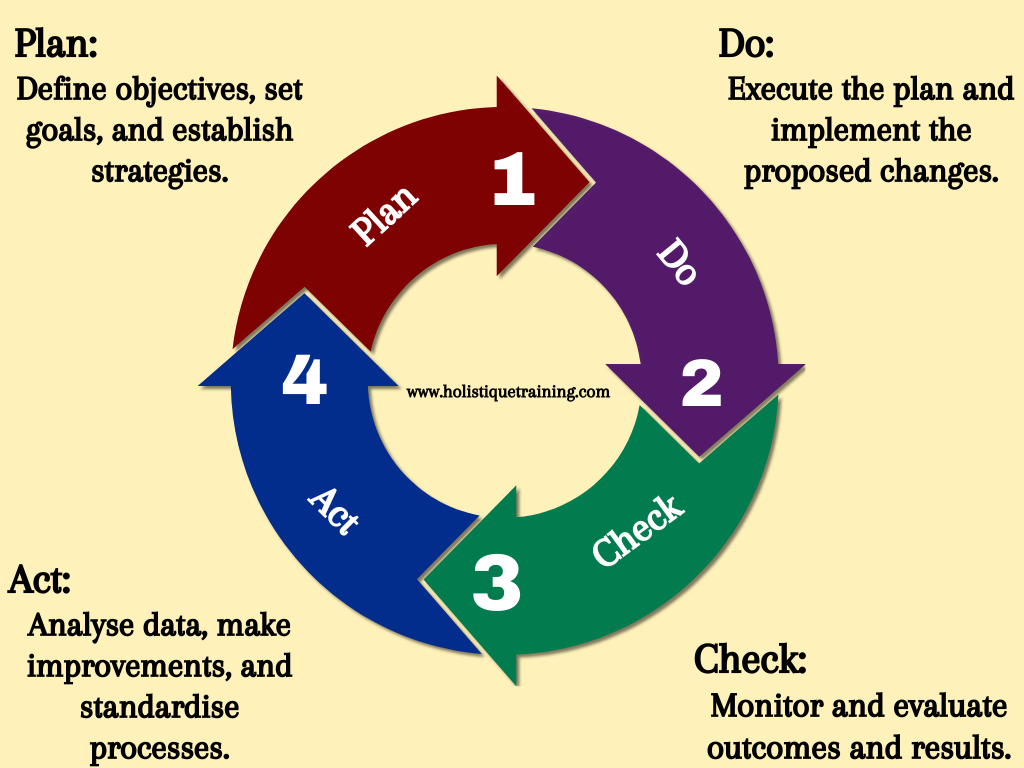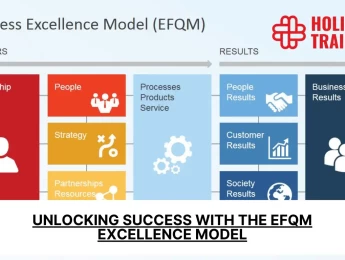- Table of Contents
- Introduction
- Understanding the Deming Cycle (or PDCA): Step-by-Step Procedure
- The History of the Deming Cycle
- When Should You Use the Deming Cycle?
- The Deming Cycle and Lean Management
- 8 Benefits of the Deming Cycle
- How to Apply the Deming Cycle at Your Organisation
- How PDSA Is Employed in the Medical Field
- The Deming Cycle in the Technological Era
- Conclusion
Introduction
Every successful venture, be it in business, healthcare, or technology, thrives on effective planning, execution, and continuous improvement. One methodology that encapsulates these principles is the Deming Cycle, also known as PDCA (Plan-Do-Check-Act). This structured approach to problem-solving and process improvement has proven instrumental in countless success stories across various fields. In this exploration, we delve into the intricacies of the Deming Cycle, its historical evolution, and its multifaceted applications in today's dynamic world.
Understanding the Deming Cycle (or PDCA): Step-by-Step Procedure
The Deming Cycle, often referred to as PDCA (Plan-Do-Check-Act), is a methodical, four-stage approach to process improvement and problem-solving. It's a framework that empowers organisations to systematically address challenges, optimise operations, and drive continuous improvement.
1. Planning (P)
The first step, Planning, is the foundation of the Deming Cycle. Here, organisations meticulously define their objectives, what they aim to achieve, and why they are pursuing improvement. This stage involves the following key elements:
- Organisations identify specific processes or areas that need improvement. This could range from enhancing product quality to reducing production costs, improving customer service, or streamlining supply chain operations.
- Well-defined objectives are established, outlining what success looks like. These goals need to be SMART (specific, measurable, achievable, relevant, and time-bound) to provide a clear target for improvement.
- A comprehensive plan is developed to outline how these objectives will be met. This strategy may encompass changes to procedures, policies, and resource allocation.
- Planning also involves determining the necessary resources, be it personnel, finances, or technology, to execute the strategy effectively.
- Organisations must assess potential risks and challenges that may arise during the implementation of their improvement plan. Identifying these early allows for proactive solutions.
2. Doing (D)
The Doing phase involves the actual implementation of the planned changes, but it's important to emphasise that in this stage, the changes are typically rolled out on a small scale or in a controlled environment. This controlled implementation serves as a testbed for several reasons:
- Implementing changes on a limited scale enables organisations to identify any unanticipated challenges or obstacles that may not have been apparent during the planning stage.
- It's also a stage where hypotheses and assumptions about the improvement are tested to see if they yield the expected results. This step is invaluable as it can prevent large-scale implementation of ineffective strategies.
- Throughout this phase, data is collected to evaluate the impact of the changes. This data will be vital in the upcoming Check phase.
3. Checking (C)
The third phase, Checking, involves evaluating the results against the goals established during the Planning stage. It's a critical checkpoint in the Deming Cycle that involves several key activities:
- Collected data is thoroughly analysed to assess whether the changes have had the desired effect. This analysis helps identify areas where improvement has been achieved and where further adjustments are needed.
- The outcomes are compared to the initial goals set in the Planning phase. This comparison can reveal whether the objectives have been met or if there are gaps that require further attention.
- The Checking phase provides insights into what worked and what didn't. Organisations can determine which changes had a positive impact and which need modification or a different approach.
4. Acting (A)
The final stage, Acting, is where organisations take the insights gained during the Checking phase and act upon them to refine the processes. It involves:
- Based on the evaluation of results, organisations make necessary adjustments and modifications to the processes. These changes are aimed at improving the effectiveness and efficiency of the systems.
- If the test phase was successful and the improvements proved beneficial, the changes can be scaled up and integrated into regular operations. It's crucial to ensure that all relevant stakeholders are informed about the changes and are aligned with the new processes.
- The Deming Cycle is a continuous loop. The lessons learned in the current cycle feed into the Planning stage of the next cycle. This ensures that the organisation is constantly in pursuit of improvement and adapting to changing circumstances.
In essence, the Deming Cycle is a powerful and structured approach that empowers organisations to continually evolve and excel. It promotes a culture of ongoing improvement, adaptability, and data-driven decision-making, making it a valuable framework for achieving excellence in various fields.

Visualisation of The Deming Cycle
The History of the Deming Cycle
To truly understand the significance of the Deming Cycle, we must delve into its intriguing history, a narrative marked by resilience, transformation, and global impact.
The Early Roots: Scientific Management and Quality Control
The origins of the Deming Cycle can be traced back to the early 20th century when pioneers like Frederick Winslow Taylor and Frank Gilbreth laid the foundation for scientific management. Taylor's principles focused on optimising efficiency and productivity through systematic analysis and standardisation of work processes. Concurrently, Gilbreth emphasised motion studies, seeking to eliminate unnecessary movements and streamline operations.
In the 1920s and 1930s, the concept of statistical quality control gained prominence, thanks to the work of experts like Walter Shewhart. Shewhart, often considered the father of statistical quality control, introduced the concept of the control chart, a graphical tool used to monitor processes and identify variations. These early developments sowed the seeds for what would later become the Deming Cycle.
Post-WWII: Deming's Influence on Japan
The transformative phase of the Deming Cycle began after World War II, during the reconstruction of war-torn Japan. In 1947, the United States invited Dr. W. Edwards Deming, a statistician and quality expert, to impart his knowledge on statistical quality control and process improvement to Japanese engineers and businessmen.
Deming's teachings were revolutionary. He emphasised the importance of quality, not just in products, but also in management and processes. His famous 14 Points for Management laid out a comprehensive philosophy for organisational transformation. One of the key principles was the Plan-Do-Check-Act cycle, which formed the core of his teachings. Deming's influence played a pivotal role in the rise of Japanese industries, turning them into global leaders in quality and efficiency.
Global Spread and Modern Applications
Following Japan's remarkable success, the Deming Cycle gradually gained recognition worldwide. It became an integral part of Total Quality Management (TQM), a management approach aimed at long-term success through customer satisfaction. In the latter half of the 20th century, many Western companies started embracing the Deming Cycle and its principles to enhance their own processes and quality standards.
As industries evolved and technology advanced, the Deming Cycle found new applications in diverse fields. From manufacturing and healthcare to software development and service industries, the PDCA framework became a universal tool for continuous improvement.
Legacy and Continuing Impact
Today, the Deming Cycle stands as a testament to the enduring power of systematic improvement. Deming's contributions not only transformed industries but also influenced generations of managers and leaders. His philosophy emphasised the importance of collaboration, statistical analysis, and a relentless pursuit of excellence.
In essence, the history of the Deming Cycle is a story of innovation, adaptability, and the global exchange of knowledge. It showcases the profound impact that a structured approach to improvement can have on organisations and, by extension, the world economy. As we move forward into an increasingly complex and competitive future, the lessons from the history of the Deming Cycle remain invaluable, reminding us of the transformative potential of continuous improvement and quality management.
When Should You Use the Deming Cycle?
The Deming Cycle, with its systematic approach to improvement, is a versatile tool applicable in a myriad of scenarios. Its adaptive nature makes it a valuable methodology in various situations, guiding organisations and individuals toward efficient problem-solving and continuous enhancement. So, when exactly should you employ the Deming Cycle? Here are some key scenarios where it proves exceptionally beneficial:
Process Optimisation and Improvement
The Deming Cycle is ideal when you need to optimise existing processes or improve inefficient workflows. Whether it's manufacturing processes, supply chain management, customer service protocols, or administrative workflows, PDCA offers a structured framework to identify bottlenecks, experiment with solutions, and implement changes systematically.
Quality Control and Assurance
Organisations that prioritise quality in their products or services can leverage the Deming Cycle. By implementing PDCA, they can continually assess quality standards, identify defects or issues, and implement corrective measures. This is particularly vital in industries where precision and consistency are paramount, such as manufacturing, healthcare, and software development.
Problem-Solving and Root Cause Analysis
When faced with complex problems, the Deming Cycle provides a systematic method to identify root causes and develop effective solutions. By following the PDCA steps, organisations can experiment with different approaches, analyse outcomes, and refine their strategies until they find the most effective solution to the problem at hand.
Innovative Initiatives and New Product Development
Innovation often requires experimentation and iterative development. The Deming Cycle allows businesses to test new ideas, products, or features in controlled environments. By applying PDCA, companies can gauge customer responses, analyse feedback, and refine innovations before launching them on a larger scale, minimising risks associated with new ventures.
Change Management and Organisational Development
Introducing organisational changes, whether in structure, culture, or policies, can be a daunting task. PDCA offers a structured approach to manage change effectively. By planning, implementing changes on a small scale, evaluating the outcomes, and acting based on the results, organisations can navigate transitions smoothly and ensure that the changes align with the desired objectives.
Training and Skill Development
In educational and training contexts, the Deming Cycle can be utilised to enhance learning experiences. Educators and trainers can plan their curriculum, test teaching methods, assess learning outcomes, and adapt their approaches based on students' performance. This iterative process ensures continuous improvement in the delivery of education and training programmes.
Customer Service Enhancement
Customer satisfaction is the cornerstone of any successful business. PDCA can be applied to improve customer service processes. By analysing customer feedback, experimenting with different service approaches, and measuring customer satisfaction levels, businesses can consistently enhance their customer service offerings, leading to increased customer loyalty and positive brand reputation.
Risk Management and Crisis Response
During times of crisis or uncertainty, organisations can use the Deming Cycle to manage risks effectively. By planning for potential risks, implementing risk mitigation strategies, evaluating their effectiveness, and adapting as needed, businesses can navigate challenges with agility and resilience.
In short, the Deming Cycle is not confined to a specific industry or circumstance. Its flexibility and adaptability make it an invaluable tool for anyone aiming for continuous improvement, problem-solving, and organisational excellence. Whether you are a small business striving for efficiency or a multinational corporation aiming for innovation, the Deming Cycle provides a structured pathway toward success in the face of evolving challenges and opportunities.
The Deming Cycle and Lean Management
Lean management, a methodology aimed at maximising value while minimising waste, shares a symbiotic relationship with the Deming Cycle. The iterative nature of PDCA aligns seamlessly with the principles of lean management. By identifying and eliminating waste in each cycle, organisations can achieve higher efficiency, reduced costs, and improved overall quality. The Deming Cycle serves as a cornerstone in the implementation of lean practices, enabling businesses to achieve operational excellence.
Benefits of PDCA in Lean Management | Applications in Lean Business Practices | Impact on Organisational Efficiency |
Continuous process optimisation and waste reduction | Implementing Kanban and Just-in-Time systems | Streamlining workflows for maximum productivity |
Data-driven decision-making for rapid improvements | Visual management techniques for enhanced visibility | Enhancing communication within cross-functional teams |
Identifying root causes for efficient problem-solving | Value stream mapping for process visualisation | Eliminating bottlenecks in production processes |
Facilitating a culture of employee involvement | 5S methodology for workplace organisation | Fostering a proactive and engaged workforce |
Standardising processes for consistent quality | Total Productive Maintenance (TPM) for equipment reliability | Improving overall equipment effectiveness (OEE) rates |
8 Benefits of the Deming Cycle
Implementing the Deming Cycle (PDCA) in an organisation brings forth a multitude of benefits that resonate across different aspects of the business. This structured approach to continuous improvement offers not just a framework but a pathway toward excellence. Here are eight significant benefits of employing the Deming Cycle:
1. Improved Product Quality
One of the primary advantages of the Deming Cycle is its ability to enhance product quality. By constantly evaluating and refining processes, organisations can identify defects and inefficiencies, leading to higher quality products or services. This improvement directly translates into increased customer satisfaction and loyalty.
2. Enhanced Customer Satisfaction
The iterative nature of the Deming Cycle ensures that customer feedback is taken into account during the checking and acting phases. By addressing customer concerns and continuously refining processes based on their feedback, businesses can deliver better services, leading to higher levels of customer satisfaction. Satisfied customers are more likely to remain loyal and recommend the business to others.
3. Increased Efficiency and Productivity
Through the Deming Cycle, organisations can identify and eliminate wasteful practices and bottlenecks in their processes. By optimising workflows and resource allocation, businesses can significantly enhance efficiency and productivity. This results in reduced lead times, faster delivery of products or services, and higher overall output.
4. Cost Reduction
By eliminating waste, streamlining processes, and optimising resources, the Deming Cycle helps in reducing operational costs. Efficient processes require fewer resources, leading to lower production costs and increased profitability. Cost savings can then be redirected into strategic initiatives or passed on to customers, further enhancing the organisation's competitive edge.
5. Empowered Workforce
The Deming Cycle promotes a culture of continuous improvement within the organisation. When employees are actively involved in the PDCA process, they feel empowered and valued. Their insights and suggestions are considered, fostering a sense of ownership and engagement. Empowered employees are more motivated, leading to higher morale, improved teamwork, and a positive work environment.
6. Informed Decision-Making
Data-driven decision-making is at the core of the Deming Cycle. By collecting and analysing relevant data at each stage, organisations gain valuable insights into their processes. Informed decisions based on concrete data lead to more accurate problem-solving and strategy development. This, in turn, ensures that the organisation's efforts are focused on areas that truly require improvement, maximising the impact of their initiatives.
7. Proactive Problem Solving
The PDCA framework encourages proactive problem-solving. Instead of merely reacting to issues as they arise, organisations can anticipate potential problems during the planning phase, devise strategies to mitigate them, and continuously monitor their effectiveness. This proactive approach minimises the impact of problems on operations and customer satisfaction.
8. Sustainable Competitive Advantage
Implementing the Deming Cycle leads to a culture of continuous improvement and innovation. Organisations that continually refine their processes, enhance quality, and adapt to changing market demands gain a sustainable competitive advantage. By staying ahead of the competition and consistently delivering high-quality products or services, businesses can secure their position in the market and even expand their market share.
In summary, the Deming Cycle is not merely a tool for incremental improvement; it's a catalyst for transformative change. The benefits it offers extend beyond the operational realm, permeating the entire organisation and its relationships with customers. By embracing the PDCA methodology, businesses can achieve a cycle of perpetual enhancement, ensuring their relevance, efficiency, and success in an ever-evolving business landscape.
How to Apply the Deming Cycle at Your Organisation
Implementing the Deming Cycle (PDCA) within your organisation's processes can be a game-changer. It provides a structured approach to problem-solving and continuous improvement, fostering a culture of excellence and adaptability. Not only that but it also leads to elevated quality standards and heightened productivity, enhancing an organisation's competitive standing, according to Business Enterprise Mapping. So, if you’re not implementing it yet, here’s your sign to start doing that. That being said, let’s explore how you can effectively apply the Deming Cycle to enhance your business processes:
1. Identify Areas for Improvement
The first step in applying the Deming Cycle is to identify specific processes within your organisation that require improvement. These could be areas with inefficiencies, bottlenecks, high error rates, or low customer satisfaction. Careful analysis and input from employees can help pinpoint these areas accurately.
2. Set Clear Objectives
Once you've identified the areas for improvement, establish clear, measurable objectives. These objectives should be specific, realistic, and time-bound. For example, if you're addressing customer service, an objective could be to reduce response time to customer queries by 20% within the next quarter.
3. Plan Thoroughly
In the Planning phase, create a detailed strategy to achieve your objectives. This plan should outline the steps to be taken, the resources required, and the expected outcomes. It’s crucial to involve relevant stakeholders and subject matter experts in the planning process to ensure a comprehensive approach.
4. Implement Changes (Do)
This is the phase where your planned changes are put into action. Start on a small scale or in a controlled environment. Implement the changes systematically, ensuring that everyone involved understands their roles and responsibilities. Document the process meticulously to track deviations from the planned implementation.
5. Gather Data and Evaluate (Check)
During this phase, collect relevant data to evaluate the outcomes of the implemented changes. Key performance indicators (KPIs) and customer feedback are valuable sources of information. Compare the actual results with the objectives set in the planning phase. Statistical tools and data analysis techniques can aid in a thorough evaluation.
6. Act on the Results
Based on the data and evaluations, make informed decisions. If the objectives are met or exceeded, consider implementing the changes on a larger scale. If the results fall short, analyse the reasons for the discrepancies. Were the changes implemented as planned? Were there unforeseen challenges? Use this analysis to adjust your strategies, make necessary modifications, and refine the process further.
7. Standardise and Document Successful Processes
Once you’ve achieved the desired outcomes, standardise the improved processes. Document the standardised procedures comprehensively. Clear documentation ensures that everyone in the organisation understands the refined processes, and it serves as a valuable resource for training new employees.
8. Continuously Monitor and Repeat
Continuous improvement is the essence of the Deming Cycle. After standardising the improved processes, establish a system for ongoing monitoring. Regularly review the processes, gather feedback, and stay vigilant for new challenges or opportunities. If further improvements are identified, go through the PDCA cycle again, starting with the planning phase.
9. Encourage Employee Involvement
Actively involve employees at every stage of the PDCA cycle. They are often the best source of insights into existing issues and potential solutions. Encourage a culture of open communication and idea sharing. Recognise and reward employees for their contributions to the improvement process, fostering a sense of ownership and pride in their work.
10. Promote a Culture of Continuous Improvement
Finally, instil a culture of continuous improvement within your organisation. Make PDCA a part of your organisational DNA. Encourage teams to initiate their improvement projects. Celebrate successes, learn from failures, and continuously emphasise the importance of adaptability and innovation.
By following these steps and integrating the Deming Cycle into your organisational processes, you create a dynamic environment where problems are systematically solved, and processes are continually optimised. This approach not only leads to immediate improvements but also ensures that your organisation remains agile and competitive in the face of evolving challenges and market demands.
How PDSA Is Employed in the Medical Field
In the medical field, where patient safety and quality of care are paramount, the Plan-Do-Study-Act (PDSA) cycle is a fundamental tool for continuous improvement. Healthcare professionals and institutions utilise the PDSA framework to test and implement changes, ensuring that new practices are safe, effective, and result in improved patient outcomes. However, a recent survey revealed that over 25% of clinical department managers in the hospitals surveyed lack complete awareness of the PDCA cycle. Furthermore, among those who are familiar with it and incorporate it into their daily management, a significant majority neglect the crucial Check and Action steps, indicating a gap in the effective application of this valuable methodology. With that in mind, here’s how the PDSA cycle is and should be employed in the medical field:
Addressing Clinical Protocols
Medical professionals often use the PDSA cycle to refine and optimise clinical protocols. For example, a hospital might initiate a PDSA cycle to improve the protocol for managing sepsis. They would plan changes to the existing protocol, implement those changes (Do), study the outcomes by monitoring patients’ responses and treatment effectiveness (Study), and then act upon the results. If the new protocol proves successful, it might be integrated into standard practice.
Medication Management
Medication errors can have serious consequences. Hospitals and clinics employ the PDSA cycle to enhance medication management processes. This might involve testing new methods of administering medications, implementing electronic prescription systems, or introducing barcode scanning for medication verification. The PDSA cycle allows medical professionals to monitor the impact of these changes on patient safety and medication accuracy.
Reducing Hospital-Acquired Infections
Hospitals continuously strive to reduce the incidence of hospital-acquired infections. Through the PDSA cycle, they can experiment with different hand hygiene protocols, isolation procedures, or sterilisation techniques. By studying infection rates and patient outcomes, healthcare providers can refine these processes, ensuring a safer environment for patients.
Streamlining Emergency Room Processes
Emergency departments often experience challenges related to patient flow, waiting times, and overall efficiency. Using the PDSA cycle, hospitals can test new patient triage methods, optimise communication between departments, and implement protocols for faster diagnostics. Studying the impact of these changes in real-time allows for rapid adjustments, leading to improved patient experiences and more efficient use of medical resources.
Enhancing Patient Education and Communication
Effective communication between healthcare providers and patients is crucial. Medical professionals apply the PDSA cycle to test different communication strategies and educational materials. This might involve experimenting with multimedia resources, interactive workshops, or digital platforms for patient engagement. Evaluating patient comprehension and engagement helps in refining these educational approaches.
Implementing New Technologies
The healthcare sector is increasingly adopting advanced technologies like telemedicine, electronic health records, and wearable devices. The PDSA cycle is employed to test the integration of these technologies into existing healthcare workflows. By monitoring the impact on patient care, data accuracy, and staff efficiency, medical institutions can make informed decisions about the adoption and customisation of these technologies.
Optimising Surgical Procedures
Surgeons and operating room teams utilise the PDSA cycle to optimise surgical procedures. This may involve testing new techniques, surgical instruments, or anaesthesia protocols. By studying patient outcomes, complications, and recovery times, surgical teams can refine their methods, ensuring safer surgeries and better post-operative care.
Enhancing End-of-Life Care
Palliative care and end-of-life services benefit from the PDSA cycle as well. Medical professionals can experiment with different pain management protocols, emotional support strategies, and bereavement services. Regular evaluation of patient and family feedback allows for adjustments, ensuring that individuals receive compassionate and comprehensive end-of-life care.
In the medical field, the PDSA cycle’s iterative nature is particularly valuable. It allows healthcare providers to respond promptly to changing patient needs, scientific advancements, and regulatory requirements. By employing this methodical approach to improvement, the medical community ensures that patient safety, care quality, and overall healthcare experiences continue to evolve positively, leading to better outcomes and enhanced patient satisfaction.
The Deming Cycle in the Technological Era
In the ever-evolving landscape of technology, where innovation is the lifeblood of progress, the Deming Cycle (PDCA) remains a steadfast compass guiding organisations toward excellence and adaptability. In the technological era, characterised by rapid advancements, complex challenges, and unparalleled opportunities, the Deming Cycle finds new relevance and applications. Here’s how this time-tested methodology is employed in the technological realm:
Agile Software Development
Agile methodologies, epitomised by iterative development and continuous feedback, align seamlessly with the principles of the Deming Cycle. Agile teams plan their sprints (Plan), execute tasks and create software increments (Do), evaluate the outcomes through user feedback and testing (Study), and make necessary adjustments to the next sprint (Act). This iterative approach ensures that software products are continually refined, meeting user expectations in an ever-changing market.
Quality Assurance and Testing
In software development, ensuring the quality and reliability of products is paramount. QA teams employ the PDCA cycle to plan test scenarios, execute tests, analyse results, and implement necessary code changes. Continuous testing and iterative improvement based on feedback enhance software robustness, leading to superior user experiences and reduced post-launch issues.
Cybersecurity and Risk Management
The Deming Cycle is instrumental in the realm of cybersecurity. Organisations use the cycle to plan security measures, implement them, study vulnerabilities through penetration testing and threat analysis, and adjust security protocols accordingly. This approach ensures that cybersecurity measures are not static but evolve in response to emerging threats, safeguarding digital assets in an ever-changing threat landscape.
User Experience (UX) Design
User-centred design is foundational in the technological era. PDCA is applied in UX design by planning user interactions and interfaces, designing and implementing these features, studying user behaviour through usability testing and analytics, and refining designs based on user feedback. This iterative process results in intuitive, user-friendly interfaces, enhancing customer satisfaction and engagement.
Data Analysis and Artificial Intelligence (AI)
The Deming Cycle is crucial in the realm of data analysis and AI. Data scientists and AI engineers plan algorithms and models (Plan), deploy them on datasets and observe their performance (Do), analyse results and adjust algorithms for better accuracy (Study), and continuously refine models based on real-world data (Act). This iterative process underpins the evolution of AI, enabling machines to learn and adapt autonomously.
Continuous System and Software Updates
The rapid pace of technological advancements often requires continuous updates to software and systems. Technology companies utilise the PDCA cycle to plan updates, roll them out, monitor performance and user feedback (Study), and implement necessary changes or patches (Act). This iterative approach ensures that products are not just launched but are constantly enhanced, meeting the ever-changing needs of users.
Innovation and New Product Development
For tech companies, the Deming Cycle is a fundamental tool for innovation. It allows for the systematic planning, development, evaluation, and refinement of new products and services. By continuously studying market feedback and adjusting features and functionalities, organisations can launch innovative products that resonate with users, leading to market success and customer loyalty.
Project Management and Collaboration Tools
Project management tools and collaboration platforms often undergo iterative enhancements. Developers and project managers employ the PDCA cycle to plan new features, implement them, gather user feedback, and make necessary adjustments. This iterative development ensures that these tools are always evolving, meeting the diverse needs of teams and organisations in the digital age.
In essence, the Deming Cycle serves as a guiding principle in the technological era, where adaptability, innovation, and user satisfaction are paramount. By embracing this systematic approach to improvement, technology companies can not only keep pace with rapid advancements but also lead the charge, shaping the future of technology and providing solutions that truly make a difference in the world. The Deming Cycle, in the technological context, isn’t just a methodology; it’s a philosophy that fuels progress and excellence in an ever-accelerating digital landscape.
Conclusion
The Deming Cycle, with its rich history, versatile applications, and numerous benefits, stands as a beacon guiding organisations toward excellence. By embracing this systematic approach to continuous improvement, businesses, healthcare institutions, and tech companies can navigate the complexities of the modern world with confidence. The Deming Cycle not only enhances processes but also nurtures a culture of innovation, adaptability, and excellence, making it a cornerstone of success in today's dynamic landscape.
And, if you're eager to master the art of continuous improvement and elevate your leadership skills to new heights, our course, ‘Perfecting Your Management & Leadership Skills,’ is your gateway to transformative learning. Enrol now and embark on a journey toward becoming a visionary leader, driving innovation, and shaping the future of your organisation. Don't just stay ahead; lead the way in the realm of effective management and leadership!
























